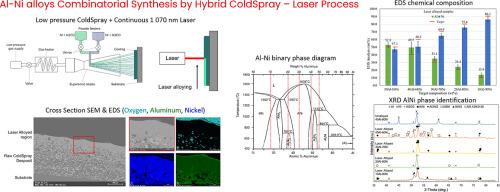通过低压冷喷沉积和激光后合金化工艺组合合成铝镍合金
IF 5.3
2区 材料科学
Q1 MATERIALS SCIENCE, COATINGS & FILMS
引用次数: 0
摘要
铝镍(AlNi)合金因其优异的高温耐磨性和耐腐蚀性而备受关注,在运输、能源和材料加工等应用领域具有重要价值。然而,这些合金的生产和成型,尤其是厚涂层的生产和成型,仍然面临着巨大的挑战。本研究介绍了一种高通量合成铝镍涂层的创新方法,该方法采用两步工艺:低压冷喷沉积,然后进行激光表面合金化。这两种技术的结合不仅改进了合成工艺,还为探索具有特定应用要求的新材料成分开辟了途径。铝粉和镍粉被共同喷涂成涂层,可控成分从 50Al50Ni 到 10Al90Ni(重量百分比)不等。随后的激光处理诱导了原位合金化和均匀化,产生了致密、均匀的铝镍涂层。使用扫描电子显微镜(SEM)和能量色散 X 射线光谱(EDS)对微观结构和化学成分进行了表征,而 X 射线衍射(XRD)则确定了各种相的形成,包括 Al3Ni 和 AlNi3 相。该工艺显示了有效的合金化和微观结构的均匀性,表面存在残余氧化铝。尽管存在裂纹等微观结构缺陷,但这种方法为进一步完善提供了坚实的基础,并为通过组合冷喷和激光合金化技术定制合金特性提供了新的可能性。本文章由计算机程序翻译,如有差异,请以英文原文为准。

Combinatorial synthesis of AlNi alloys by low-pressure cold spray deposition and post-laser alloying process
Aluminum-Nickel (Al![]() Ni) alloys are of great interest due to their exceptional high-temperature wear and corrosion resistance, making them valuable in transport, energy, and materials processing applications. However, challenges in the production and shaping of these alloys, particularly as thick coatings, remain significant. This study introduces an innovative method for the high-throughput synthesis of Al
Ni) alloys are of great interest due to their exceptional high-temperature wear and corrosion resistance, making them valuable in transport, energy, and materials processing applications. However, challenges in the production and shaping of these alloys, particularly as thick coatings, remain significant. This study introduces an innovative method for the high-throughput synthesis of Al![]() Ni coatings, utilizing a two-step process: low-pressure cold spray deposition followed by laser surface alloying. The combination of these two techniques not only improves the synthesis process but also opens avenues for exploring new material compositions with specific application requirements. This approach holds significant potential for accelerating the development and optimization of advanced coatings and multiphase compounds in applications such as repair and additive manufacturing.
Ni coatings, utilizing a two-step process: low-pressure cold spray deposition followed by laser surface alloying. The combination of these two techniques not only improves the synthesis process but also opens avenues for exploring new material compositions with specific application requirements. This approach holds significant potential for accelerating the development and optimization of advanced coatings and multiphase compounds in applications such as repair and additive manufacturing.
Aluminum and nickel powders were co-sprayed to create coatings with controlled compositions ranging from 50Al![]() 50Ni to 10Al
50Ni to 10Al![]() 90Ni (wt%). Subsequent laser treatment induced in-situ alloying and homogenization, resulting in dense, uniform Al
90Ni (wt%). Subsequent laser treatment induced in-situ alloying and homogenization, resulting in dense, uniform Al![]() Ni coatings. The microstructure and chemical composition were characterized using Scanning Electron Microscopy (SEM) and Energy Dispersive X-ray Spectroscopy (EDS), while X-ray Diffraction (XRD) identified the formation of various phases, including Al3Ni and AlNi3 phases. The process demonstrated effective alloying and microstructural homogeneity, with residual alumina present at the surface. Despite the presence of some microstructural defects, such as cracking, this method provides a robust foundation for further refinement and opens new possibilities for tailoring alloy properties through combinatorial cold spray and laser alloying techniques.
Ni coatings. The microstructure and chemical composition were characterized using Scanning Electron Microscopy (SEM) and Energy Dispersive X-ray Spectroscopy (EDS), while X-ray Diffraction (XRD) identified the formation of various phases, including Al3Ni and AlNi3 phases. The process demonstrated effective alloying and microstructural homogeneity, with residual alumina present at the surface. Despite the presence of some microstructural defects, such as cracking, this method provides a robust foundation for further refinement and opens new possibilities for tailoring alloy properties through combinatorial cold spray and laser alloying techniques.
求助全文
通过发布文献求助,成功后即可免费获取论文全文。
去求助
来源期刊

Surface & Coatings Technology
工程技术-材料科学:膜
CiteScore
10.00
自引率
11.10%
发文量
921
审稿时长
19 days
期刊介绍:
Surface and Coatings Technology is an international archival journal publishing scientific papers on significant developments in surface and interface engineering to modify and improve the surface properties of materials for protection in demanding contact conditions or aggressive environments, or for enhanced functional performance. Contributions range from original scientific articles concerned with fundamental and applied aspects of research or direct applications of metallic, inorganic, organic and composite coatings, to invited reviews of current technology in specific areas. Papers submitted to this journal are expected to be in line with the following aspects in processes, and properties/performance:
A. Processes: Physical and chemical vapour deposition techniques, thermal and plasma spraying, surface modification by directed energy techniques such as ion, electron and laser beams, thermo-chemical treatment, wet chemical and electrochemical processes such as plating, sol-gel coating, anodization, plasma electrolytic oxidation, etc., but excluding painting.
B. Properties/performance: friction performance, wear resistance (e.g., abrasion, erosion, fretting, etc), corrosion and oxidation resistance, thermal protection, diffusion resistance, hydrophilicity/hydrophobicity, and properties relevant to smart materials behaviour and enhanced multifunctional performance for environmental, energy and medical applications, but excluding device aspects.
 求助内容:
求助内容: 应助结果提醒方式:
应助结果提醒方式:


